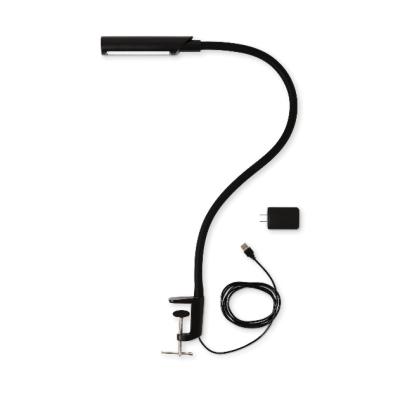
The Reliable Uberlight is an affordable solution to light up your work area and your world with up to 600 lumens, 9 settings, (2700k, 4000k, 5000k, and 3 color settings – warm white, natural white, or ultra bright). This allows each machinist, tool and die maker, CNC operator, or fabricator to choose the combination that works the best for their work, whether it is a cool bright light or a warm sunny light, Reliable and KBC provide the task lighting to get the job done without eye strain.
The Reliable Uberlight comes in black or white and 3 styles: with a convenient clamp mount to easily mount on any machinery or worktable, with a 7.75” base to prevent tipping, or a direct table mount, (black only, shown below. With its 26.5” silicone gooseneck and 270 degree rotational head the Reliable Uberlight allows light precisely where needed with a great hold. The 4.75” LED panel does not create glare or flickering and provides up to 60,000 hours of use and 240% more luminous efficiency. All provided with a 6’ USB cord and adapter.
@wrightmachining recently commented on KBC’s Instagram post, "It's a great light, game changer at the milling machine." KBC adds that it can be a gamechanger on any of the machines in a shop, or in assembly, inspection, or design areas, as well as for home use for work and hobbies. When tools, workpieces, and machining can be seen clearly, rework and mistakes diminish.
Contact Details
Related Glossary Terms
- computer numerical control ( CNC)
computer numerical control ( CNC)
Microprocessor-based controller dedicated to a machine tool that permits the creation or modification of parts. Programmed numerical control activates the machine’s servos and spindle drives and controls the various machining operations. See DNC, direct numerical control; NC, numerical control.
- gang cutting ( milling)
gang cutting ( milling)
Machining with several cutters mounted on a single arbor, generally for simultaneous cutting.
- milling
milling
Machining operation in which metal or other material is removed by applying power to a rotating cutter. In vertical milling, the cutting tool is mounted vertically on the spindle. In horizontal milling, the cutting tool is mounted horizontally, either directly on the spindle or on an arbor. Horizontal milling is further broken down into conventional milling, where the cutter rotates opposite the direction of feed, or “up” into the workpiece; and climb milling, where the cutter rotates in the direction of feed, or “down” into the workpiece. Milling operations include plane or surface milling, endmilling, facemilling, angle milling, form milling and profiling.
- milling machine ( mill)
milling machine ( mill)
Runs endmills and arbor-mounted milling cutters. Features include a head with a spindle that drives the cutters; a column, knee and table that provide motion in the three Cartesian axes; and a base that supports the components and houses the cutting-fluid pump and reservoir. The work is mounted on the table and fed into the rotating cutter or endmill to accomplish the milling steps; vertical milling machines also feed endmills into the work by means of a spindle-mounted quill. Models range from small manual machines to big bed-type and duplex mills. All take one of three basic forms: vertical, horizontal or convertible horizontal/vertical. Vertical machines may be knee-type (the table is mounted on a knee that can be elevated) or bed-type (the table is securely supported and only moves horizontally). In general, horizontal machines are bigger and more powerful, while vertical machines are lighter but more versatile and easier to set up and operate.
